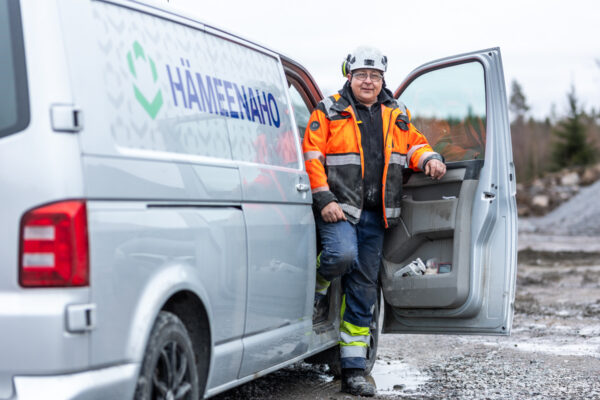
Supervisor Matti Kärjä: earthwork and crushing requires constant development
Matti’s career in earthworks began when he was still a teenager, and after serving in the army, it continued with different employees, mainly in mining projects in quarrying and transport of stone materials. In January 2024, Matti became a supervisor at the Hämeenaho family company.
The current work as a supervisor includes office days, but Matti explains that he mostly likes working in the field.
“I am a practical man. I think I might be a kindred spirit with the owners of Hämeenaho, because I am most at home at the site.”
Matti had an existing contact with Hämeenaho.
“I have been working at the same sites but with a different employer, and have even talked with Jari and Ari. I also know people, who have worked, and some that still work, at Hämeenaho. I think I might have even ended up working at Hämeenaho because of people I know.”
In his current work, Matti deals with offer calculations and gets to work at the site crushing stones.
“Quarrying and crushing will be my responsibilities.”
Working at Hämeenaho will be the first time Matti is able to commute to work from home. Of course, some sites might still require travelling.
“We move around with earthworks contracts and sites,but I myself have still been able to commute from home.”
Quality work in a more efficient way
Out of the stone material crushed by Hämeenaho, practically everything goes to infrastructural constructions and road maintenance. Certain portion of the deliveries are also concrete and asphalt stones.
According to Matti, customers know what they are buyng.
“I of course present them with options, if I think that another solution would produce stone material that meets the quality criteria in a more cost-efficient way. For example, we have to account for fuel costs, how we are able to minimise it in the current project.” The crushing can be done at either Hämeenaho’s or customer’s quarry.
“We are actually crushing stone at a customer’s quarry at the moment. We always consider the most cost-efficient solution. In this case, we moved the crusher to the customer’s pit. It is relatively easy to move our crusher on a carriage, and at the site, it can be pretty easily moved a couple hundred metres on its own crawler.”
“During winter, we crush storage piles for the customer, so that once the ground is unfrozen, they have construction materials ready.”
Hämeenaho’s customers have their own customers that usually define the quality requirements and grain size of the stone material. Usually, the customer also organises the material transport, but there are exceptions.
“For example, we transported the stone material for the wind park construction sites that Hämeenaho has worked on with our own equipment. The main method is to crush ready-to-take piles for the customers, and they will then transport the piles to their site as they need them.”
During winter, Hämeenaho crushes storage piles for the customer, so that once the ground is unfrozen, they have construction materials ready.
There are differences in the quality of solid rock and stone materials, and they go through strict control measures before and during crushing.
“For example, crushed stone used in railways and materials for asphalt need to be high in quality, and even the crushing is a little different. The quality is assessed from a sample stone, which is used to specify the hardness and shape values in appropriate laboratories. We also take samples constantly during crushing. The CE marking even requires that the samples are taken and analysed in certain intervals.”
Crushed stone can still be well acquired in Ostrobothnia.
“The sites for natural crushed stone are pretty dried out in Southern Finland, and it is difficult to get new borrow permits. We still have it good here in the north.”

Responsibility in practice
New machinery and minimal use of fossil fuels are included in the environmentally responsible actions of Matti’s work.
“Crushing and reuse of old concrete will also be increased. And talking about crushing, Hämeenaho does also process and crush metal dross in plant environments, so that the plants’ by-products can be reused. They are able to replace natural materials.”
Environmental officials, cities and municipalities determine values and limits for the activities of quarrying and borrowing.
“Among other things, the permits specify the time we are able to operate. Drilling and quarrying, borrow depths, gradient of slopes, height of earth material storage piles, fuel and chemical storage, and many other aspects are strictly governed and also controlled. We make sure to abide by the permits precisely.”
Hämeenaho has quality and environmental certificates, and Hämeenaho is committed to follow them in their everyday operations. According to Matti, when borrowing has been done well, no one even notices that they have been at the pit.
Once we have the dust, noise and vibrations under control, the machinery operates well and schedules are followed, and the customer is satisfied, we can say that we have succeeded in our work.
“When no one notices our visit, we have succeeded.”
Matti’s long experience with earthworks and quarrying aids in customer service and understanding their needs. However, Matti is humble about his work.
“We have to learn new things constantly. The equipment and crushing technique is always developing. We can always improve on efficiency and cost-efficiency.”
In the spirit of Hämeenaho, Matti ends with:
“Let’s put our overalls on and go to work.”

